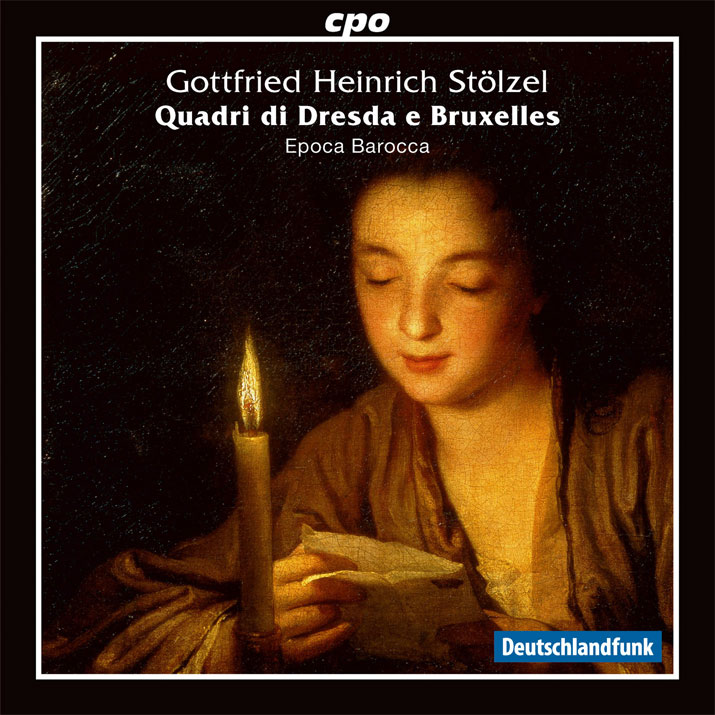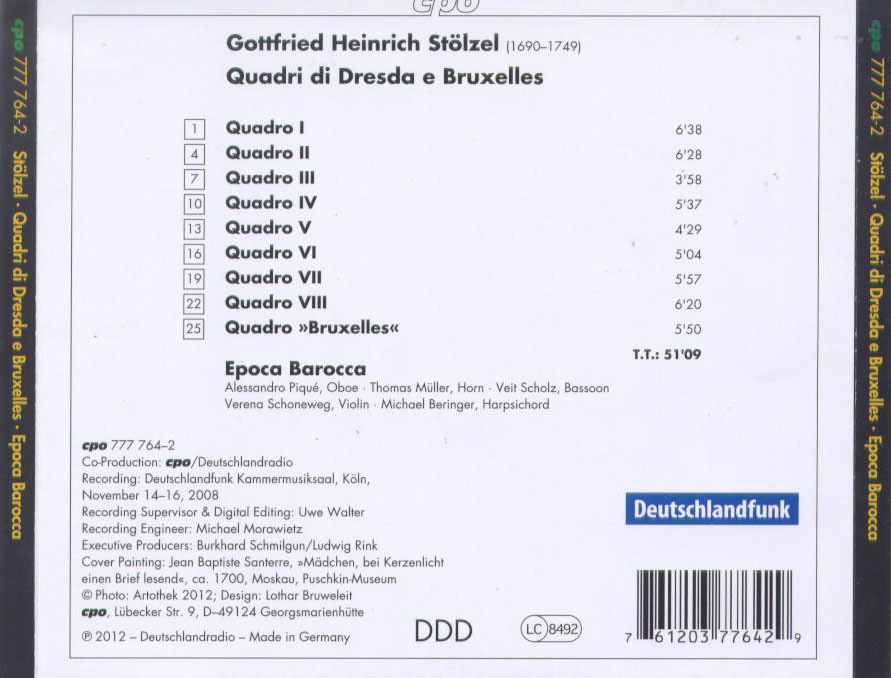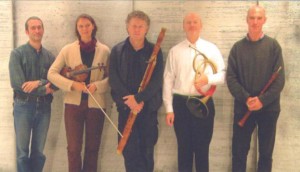Share This
Album at a Glance
Tags
Related Posts
- The Birth of the Violin, contrasting works for the early violin / Le Miroir de Musique
- Full Well She Sang, women’s music from the Middle Ages & Renaissance / The Toronto Consort
- Le Parler et le Silence - Music for flute consort / Attaignant Consort
- Johann Joachim Quantz: 4 Flute Concertos / Mary Oleskiewicz, baroque transverse flute
Gottfried Heinrich Stölzel: Quadri di Dresda e Bruxelles
Posted by Paul Ballyk on Mar 5, 2013 in Baroque | 0 comments
Like so many fine composers who are starting to receive their just due in recent times, Gottfried Heinrich Stölzel (1690-1749) was highly respected in his own day. The illustrious music library at the Dresden court in the mid-eighteenth century had Stölzel's music cataloged alongside that of Fux, Hasse, Fasch, Handel, Corelli, Locatelli and Vivaldi. Unfortunately, much of Stölzel's music has been lost. Of the approximately two dozen operas he wrote for example, hardly anything has survived. You have to wonder what music history would have to say about Stölzel if we had much more of his music. Would he be mentioned in the same breath as Telemann or Vivaldi?
Stölzel's Quadri di Dresda e Bruxelles is music that is still firmly rooted in the Baroque, coming as it did from the end of the period when the fashion was turning towards the gallant of the rococo. The nine sonatas are structurally very much alike. Each is in three movements with an Adagio framed by two fast movements, and are scored for violin, oboe, horn, bassoon and cembalo. The instrumentation of Stölzel's sonatas is not so remarkable as how he writes for the instruments. It is unusual to hear such challenging music written for horn in this setting, but Stölzel makes the three upper instruments equals in the duties of handling the melodic lines. Even the bassoon will be provided a melody at times.
We have wonderful performances from the five-member period instrument ensemble Epoca Barocca and cpo provides excellent sonics. Telemann, Vivaldi and Stölzel? We've included a complete Quadro as our musical sample, so you can be the judge.
Stölzel & Epoca Barocca
The importance of Gottfried Heinrich Stölzel was taken for granted by his contemporaries. A highly esteemed composer mentioned in the same breath with Bach, Telemann, and Handel, he was maestro di cappella at the court of Saxe-Gotha and Altenberg for thirty years. Today his name has largely vanished from our concert programs, but not from the cpo catalogue. That Stölzel did remarkable things in the field of sacred music has already been impressively demonstrated by our previous releases, including his Christmas Oratorio and Brockes Passion. Now we give you Stölzel the composer of chamber music. His Quadri di Dresda e Bruxelles for oboe, horn, bassoon, and basso continuo thrives on the Italianate concertante interplay of these instruments. Fully in line with Quantz's notion of the "mingling of concertizing instruments," Stölzel unites all three melody parts in a sensitive texture of motivic imitation where even the continuo has occasional moments of glory. He gives each player an opportunity to stand out as a soloist while the others remain discretely in the background. The members of Epoca Barocca, a chamber ensemble founded and inspired by Alessandro Piqué, again display their common passion for presenting this music on period instruments.
Source: cpo records
|
Alessandro Piqué, oboe; Thomas Müller, horn; Veit Scholz, bassoon; Verena Schoneweg,violin; Michael Beringer, harpsichord
|
|
|
|
Ensemble: Epoca Barocca The members of the chamber music ensemble Epoca Barocca share a passion for the performance of baroque music on original instruments. The focal point of the repertoire is the sonata for three or four instruments with basso continuo, generally during the period from Antonio Caldara to Jan Dismas Zelenka. For more information, please visit http://www.epocabarocca.de/.
|
|
Composer: Gottfried Heinrich Stölzel The German composer, Gottfried Heinrich Stölzel, studied at Leipzig University from 1707 to 1710, where he joined the Collegium Musicum, which had been headed by Telemann before Stölzel’s arrival at the University. J.S. Bach was said to have great respect for Gottfried Heinrich Stölzel, who was known to be a prolific composer in nearly every genre of his time. Most of Stölzel’s works have been lost. For more information, please visit http://www.bach-cantatas.com/Lib/Stolzel-Gottfried-Heinrich.htm. |
|
| Thinking about purchasing this album?
Follow this link for more album details or to make the purchase. Buy it now |
“Not just recommended. Guaranteed.”
We stand behind every album featured on Expedition Audio. Our objective is to take the monetary risk out of music exploration. If you order this album from HBDirect.com and do not like it you can return it for a refund.








